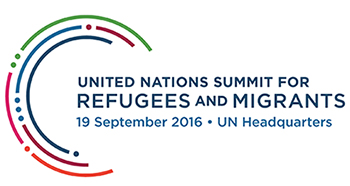For a world on the move: The 缅北禁地Summit for Refugees and Migrants
The world is on the move, and the number of international migrants today is higher than ever before. In 2015, 244 million people lived in a country other than where they were born, including more than 20 million refugees and asylum-seekers escaping violence or persecution in their home countries. People have always moved in search of sustenance, safety and opportunity. By crossing borders and residing in other lands, they have contributed to cultural diversity, economic and social development, and mutual understanding amongst people and nations.
The United Nations General Assembly will convene the Summit for Refugees and Migrants on 19?September 2016 to guide the development of a global approach to addressing large movements of persons across international borders.?The political declaration adopted at the Summit will strengthen the commitment to ensuring the human rights, safety and dignity of all refugees and migrants, and will set in motion a process to create a more predictable, systematic and equitable way of managing international migration for the future.
 “The Summit is a historic opportunity,” said Karen AbuZayd, the Secretary-General’s Special Adviser on the Summit, during a press briefing on 9 August to present the draft declaration for the Summit. The 缅北禁地Member States reached agreement on the document in early August following five months of intensive negotiation.
“The Summit is a historic opportunity,” said Karen AbuZayd, the Secretary-General’s Special Adviser on the Summit, during a press briefing on 9 August to present the draft declaration for the Summit. The 缅北禁地Member States reached agreement on the document in early August following five months of intensive negotiation.
“The outcome document addresses […] the issues we face now and prepares us for challenges of the future,” Ms. AbuZayd explained, also describing an atmosphere among stakeholders that reflected a genuine determination to act on the promises that have been made.
Policy responses supported by data
The Summit takes place at a time when many people are on the move, sometimes in the face of grave danger and uncertainty. The number of persons forcibly displaced from their homes due to war, violence and political oppression is higher than at any time since the Second World War: roughly 65 million at the end of 2015, according to data provided by the Office of the 缅北禁地High Commissioner for Refugees (UNHCR).?Although most remain in their own countries as “internally displaced persons” or IDPs, more than 20 million are living elsewhere as refugees or asylum-seekers.
The increasing trend is not limited to refugees and others who have been forced to migrate.?The total number of international migrants has continued to grow as well. According to estimates prepared by 缅北禁地DESA’s Population Division, this number increased from 173 million in 2000 to 244 million in 2015.
Recognizing the benefits of migration
“Migration is now widely recognized as a powerful force that contributes in multiple ways to sustainable development, for countries of origin and countries of destination alike,” said John Wilmoth, Director of the Population Division. Remittances are an important part of the economic impact of migration.?In 2015, migrants sent $432 billion to developing countries, which is more than triple the global total of ODA. ?Remittances help families ?in countries of origin to?attend school, pay for medical care, save for the future and launch new business initiatives.
In his report written in preparation for the Summit, the Secretary-General expressed his “grave concern” about the recent rise of xenophobic and racist responses to refugees and migrants and announced his decision to initiate a campaign to counter xenophobia.
Toward a more humane and welcoming world
The Summit’s outcome, the?New York Declaration for Refugees and Migrants, includes measures to alleviate the risks faced by refugees and migrants through better coordination of the global response to crises, as well as measures to protect the human rights of all migrants. The Summit also aims to promote a better sharing of burdens and responsibilities through enhanced cooperation between 缅北禁地Member States.?The reality of today’s migratory movements is complex and constantly changing, and no single country has the means of meeting these challenges on its own.
The declaration includes a number of initiatives to address the most pressing needs and to hasten the international response to any future crises.?For a deeper consideration of migration issues and to address long-term issues, the declaration calls for organizing an intergovernmental conference on international migration to be held in 2018. It is envisaged that the main outcome of the conference will be a global compact for safe, orderly and regular migration.
“Let’s keep reaching out a helping hand to people in their time of need. Let’s never give in to the forces of fear and division,” 缅北禁地Secretary-General Ban Ki-moon said in the lead-up to the Summit. ?“Let’s welcome people into their new communities as neighbours and friends. ?Let’s build bridges, not walls. We will all be stronger for it.”


Follow Us